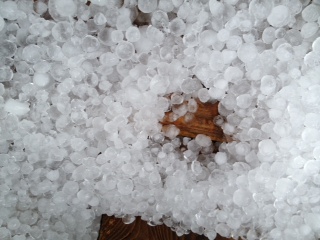By Dr. Jeff Todd
 Last week it went from 70 degrees and sunny, to a full hail storm– in about 10 minutes time. Dawn happened to be working in her home office and took this picture of the hail that covered our deck- beautiful, perfectly round marbles of ice.
Last week it went from 70 degrees and sunny, to a full hail storm– in about 10 minutes time. Dawn happened to be working in her home office and took this picture of the hail that covered our deck- beautiful, perfectly round marbles of ice.
During this hail storm the sound in the house was deafening, and I thought, if this is just the start of our season, I better start talking about storm and noise phobias early this year!
When it comes to storm phobias, I often see a dog for the very first time only after they’ve completely shredded an expensive piece of furniture, or destroyed a room. That gets your attention, but the time to intervene is much, much earlier.
If you don’t read any further, the main point I want you to remember is this…. let’s start treating anxious, noise or thunder phobic dogs early – when you first start noticing noises that make your pet anxious.
Where does noise and thunderstorm phobia begin? We don’t exactly know. There may be a genetic component. Sometimes, in the impressionable period between 8-20 weeks, a puppy gets exposed to a loud, scary noise. Most often however, storm phobias begin to develop in the 4 – 7 year-old range. This coincidentally is the period when some dogs thyroid begins under-performing. Abnormal thyroid hormone levels are linked to a range of behavioral issues.
What are dogs fearful of thunderstorms reacting to?
Many behavior experts believe there are two primary types of thunderstorm phobias.
1. Dogs reacting to the discomfort of the electrical charge in the air. Heavy coated dogs are more prone to getting static electricity shocks during storms, and over time they become increasingly fearful as they anticipate the pain of the little accumulated shocks. These are probably the dogs that launch themselves into a bathtub, or behind a toilet — they’ve figured out how to “ground” themselves. Some dogs are extraordinarily sensitive to any electrical shock.
2. Dogs that are fearful of the noise alone. Many owners report that the phobia just “appeared out of nowhere”. But it’s always possible that there was some unwitnessed trauma – like a big scary clap of thunder one day when no one was home; or a dog caught outdoors during a bad storm. I see this a lot in dogs that stay outdoors in pens when their people aren’t home. It just takes being out in one nasty storm for a phobia to begin.
What’s a responsible pet parent to do?
First, if you see your dog beginning to show signs of fear during storms, make an appointment with our office for a check-up. We’ve got to rule out any medical reasons for the behavior change. The most common medical reason for a change in behavior is pain– dental issues being at the top of the list because they’re not as obvious. Remember your dog can’t say “Hey mom, I bit that bone too hard and cracked my tooth, can you call Dr. Todd? It’s killing me!”
Next, if we can’t determine a medical reason for the emerging fear, we’ll get Dawn working with you to determine how progressed the storm phobia is – is it mild, moderate, or severe. Does it seem to be generalized or is it triggered strictly by noise alone. That determination influences what we try first.
Finally, we’ll implement a plan specifically for your situation. And let me stress, each situation is unique, and there’s no “cookie-cutter” solution for storm phobia.
What’s in our bag of tricks?
Many things. Noise desensitization programs, Rescue Remedy, DAP (dog appeasing pheromones), melatonin, storm defender capes, acupuncture, and for the most severe cases- better living through chemistry.
What’s the take away?
The earlier you intervene the better the prognosis for managing thunderstorm phobias. Left untreated, thunderstorm phobias can morph into fear of all loud noises and generalized anxiety. We’re here to help you and your pets live long happy lives together.
